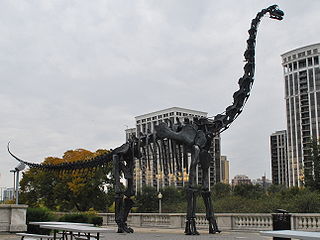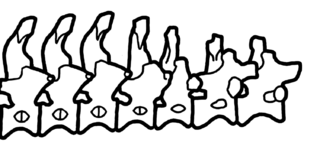
The Brachiosauridae are a family or clade of herbivorous, quadrupedal sauropod dinosaurs. Brachiosaurids had long necks that enabled them to access the leaves of tall trees that other sauropods would have been unable to reach. In addition, they possessed thick spoon-shaped teeth which helped them to consume tough plants more efficiently than other sauropods. They have also been characterized by a few unique traits or synapomorphies; dorsal vertebrae with 'rod-like' transverse processes and an ischium with an abbreviated pubic peduncle.
Agustinia is a genus of sauropod dinosaur from the Early Cretaceous of South America. The genus contains a single species, A. ligabuei, known from a single specimen that was recovered from the Lohan Cura Formation of Neuquén Province in Argentina. It lived about 116–108 million years ago, in the Aptian–Albian stages of the Early Cretaceous Period.

Aragosaurus was a genus of sauropod dinosaur from the Early Cretaceous period of Galve, province of Teruel, in the autonomous territory of Aragón, Spain. It was deposited in the Villar del Arzobispo Formation.

Sonorasaurus is a genus of brachiosaurid dinosaur from the Early to Late Cretaceous. It was a herbivorous sauropod whose fossils have been found in southern Arizona in the United States. Its name, which means "Sonora lizard", comes from the Sonora River that flows in the Sonoran Desert where its fossils were first found. The type species is S. thompsoni, described by Ratkevich in 1998.

Dinheirosaurus is a genus of diplodocid sauropod dinosaur that is known from fossils uncovered in modern-day Portugal. It may represent a species of Supersaurus. The only species is Dinheirosaurus lourinhanensis, first described by José Bonaparte and Octávio Mateus in 1999 for vertebrae and some other material from the Lourinhã Formation. Although the precise age of the formation is not known, it can be dated around the early Tithonian of the Late Jurassic.

Lusotitan is a genus of herbivorous brachiosaurid sauropod dinosaur from the Late Jurassic of Portugal and possibly Spain.

Europasaurus is a basal macronarian sauropod, a form of quadrupedal herbivorous dinosaur. It lived during the Late Jurassic of northern Germany, and has been identified as an example of insular dwarfism resulting from the isolation of a sauropod population on an island within the Lower Saxony basin.

Turiasauria is an unranked clade of basal sauropod dinosaurs known from Middle Jurassic to Early Cretaceous deposits in Europe, North America, and Africa.
Galve is a municipality located in the province of Teruel, Aragon, Spain. According to the 2006 census (INE), the municipality has a population of 145 inhabitants. There is an important paleontological site.

Tastavinsaurus is a genus of sauropod dinosaur belonging to the Titanosauriformes. It is based on a partial skeleton from the Early Cretaceous Xert Formation of Spain. The type species is Tastavinsaurus sanzi, named in honor of the Rio Tastavins in Spain and Spanish paleontologist José Luis Sanz. Tastavinsaurus sanzi is known from two specimens, one from the Xert Formation and one from the Forcall Formation. Tastavinsaurus was originally described as a somphospondylan, but it may be a brachiosaurid. The clade Laurasiformes was coined for Tastavinsaurus and its close relatives, which may include Cedarosaurus, Soriatitan, and Venenosaurus.

The Camarillas Formation is a geological formation in the Teruel Province of Aragón, Spain whose strata date back to the Early Cretaceous. The sandstones, mudstones and conglomerates of the formation, that due to syn-sedimentary faulting varies greatly in thickness from 300 to 800 metres, were deposited in fluvial, deltaic and lacustrine environments.

The Villar del Arzobispo Formation is a Late Jurassic to possibly Early Cretaceous geologic formation in eastern Spain. It is equivalent in age to the Lourinhã Formation of Portugal. It was originally thought to date from the Late Tithonian-Middle Berriasian, but more recent work suggests a Kimmeridigan-Late Tithonian, possibly dating to the Early Berriasian in some areas. The Villar del Arzobispo Formation's age in the area of Riodeva in Spain has been dated based on stratigraphic correlations as middle-upper Tithonian, approximately 145-141 million years old. In the area of Galve, the formation potentially dates into the earliest Cretaceous.
The Higueruelas (Spanish) or Higuerueles Formation (Catalan) is a Tithonian geologic formation in the Teruel and Valencia provinces of Spain. Fossil sauropod tracks have been reported from the formation.
Ageroolithus is an oogenus of dinosaur egg. It may have been laid by a theropod.

Laurasiformes is an extinct clade of sauropod dinosaurs from the late Early Cretaceous of Europe, North and South America. It was defined in 2009 by the Spanish paleontologist Rafael Royo-Torres as a clade containing sauropods more closely related to Tastavinsaurus than to Saltasaurus. Genera purported to form part of this clade include Aragosaurus, Galvesaurus, Phuwiangosaurus, Venenosaurus, Cedarosaurus, Tehuelchesaurus, Sonorasaurus and Tastavinsaurus.

Gideonmantellia is an extinct genus of basal ornithopod dinosaur known from the Early Cretaceous Camarillas Formation of Galve, Province of Teruel, Spain. It contains a single species, Gideonmantellia amosanjuanae.

Camarillasaurus is a genus of theropod dinosaur from the Early Cretaceous period (Barremian) of Camarillas, Teruel Province, in what is now northeastern Spain. Described in 2014, it was originally identified as a ceratosaurian theropod, but later studies suggested affinities to the Spinosauridae. If it does represent a spinosaur, Camarillasaurus would be one of several spinosaurid taxa known from the Iberian peninsula, the others being Iberospinus, Protathlitis, Baryonyx, Riojavenatrix, and Vallibonavenatrix.
Guegoolithus is an oogenus of fossil egg from the early Cretaceous of Spain. It is classified in the oofamily Spheroolithidae, and was probably laid by an ornithopod dinosaur.

Oblitosaurus is a genus of ankylopollexian ornithopod dinosaur from the Late Jurassic Villar del Arzobispo Formation of Spain. The type species is Oblitosaurus bunnueli.

























